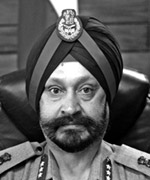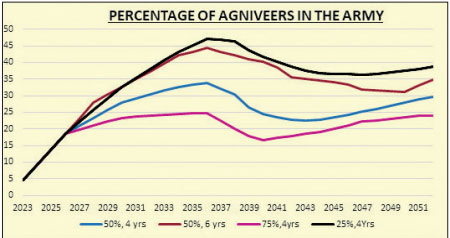The armed forces have a unique opportunity to revise and transform the Agnipath Scheme
 Lt Gen. HJS Sachdev (retd)
Lt Gen. HJS Sachdev (retd)
The Agnipath scheme was launched in June 2022, and I had put forward my analysis that same month with the finding that it was a ‘bad scheme, marketed badly’. Two years have since passed and there is a lot of feedback, views and opinions both in favour and against the scheme, mainly from the veterans’ community.
There is an extreme division in the opinions ranging from ‘path breaking reforms’ on one hand to ‘scrap it’ on the other. Never before has an idea seen such polarization amongst the veterans. The negative opinion and the public outcry against the scheme to now political exploitation by the opposition parties has once again reignited the debate and brought it back to the centre stage of public discourse. However, the most important factor that has forced the government and the armed forces to review it has been the political cost that the scheme has extracted in the recently held national elections. That is exactly what I wrote in my article Back to the Drawing Board that appeared in the July 2022 issue of FORCE.
It would be appropriate if the Agnipath scheme is revisited, analysed with the experience till date, various options available going forward explored and then adopting a path that is logical, sustainable and in the best interests of the armed forces, the nation and the most important component of the scheme, the youth. While my earlier article covering the scenario up to 2052, is available on the FORCE website, it would be helpful to summarise its key takeaways:
- The critical issue lay in the high per centage of Agniveers in the total strength of the Army as a whole and especially in the combat unit (infantry) and its adverse effect on operational effectiveness. The period between 2032 and 2042 would see unacceptable levels, with more than 40 per cent of Agniveers in the army.
- Age alone cannot be the criteria for diabolic reforms. If that was true, it may not be out of place to mention that the Indian cricket team that won the World Cup wherein fitness and experience both had a key role!
- The importance of experience cannot be understated in the making of a soldier. A war veteran will be able to contribute more effectively in combat situations than a novice trained in the classrooms with the help of high-tech training. It was felt that it takes minimum six years for a newly inducted recruit to transform into a soldier with expertise over a multitude of weapon systems and combat situations. It is exploitation of this skill thereafter till he retires that is the key to combat effectiveness—of the unit and the force.
- The intangibles like morale, motivation, stress, etc., would have an adverse impact on the unit due to high per centage of discards (75 per cent) after four years. The uncertainty of the future and in some cases, near certainty of being discharged could even create disciplinary and man management issues within the unit, an undesirable situation for any Commanding Officer.
- Lastly, the negative impact of such a large population of weapon trained youth with suitable knowledge of tactical operations on society, already witnessing a surge in polarisation, angst among communities and the violence levels across the length and breadth of the country.
The Last Two Years
Since its inception, the Agnipath scheme has been in the news for some reason or the other, be it to showcase the positives of the scheme or the supposedly great standard of Agniveers, their training, etc. The fact is that the army had no choice but to laud it because they had offered their shoulder to the government to fire the salvo in the first place. What is surprising is that the army continues to defend it even when it is under review.
The recent interview of the adjutant general spelt out ‘all is well’. Then why the review? He made it clear that the Agniveers were performing the same duties as regular soldiers which is a good thing. However, why, then, is there a disparity in their pay and allowances and compensation on death? The main issues are as follows:
- As estimated earlier, by this year end, approximately 15 per cent strength would be achieved in the army and the units—around 100 Agniveers.
- The feedback has been a mixed bag depending on whether it is on or off the record.
- There are restrictions on their employment in Rashtriya Rifles or extra regimental employment. Therefore, these duties can only be rotated amongst the balance riflemen/ sepoys.
- Differentiation in emoluments and compensation post death has not been favourably received by civil society.
- It is too early to comment on the societal effects even though an incident has come to light reflecting its negative impact.
- The rehabilitation of Agniveers by the Central Armed Police Forces (CAPF), Bharatiya Janata Party (BJP)-ruled states is a seasonal affair and is to promote a narrative that ‘all is well’. The proof of the pudding will be available only in 2027.

Options and Way Ahead
The scheme in its current avatar is no longer the favourite. We are back to the drawing board and better late than never. Much to the relief of the armed forces (privately), the tweaking of the scheme has become a political necessity.

However, there still remains a factor which will affect the new form in which it emerges, namely, the Prime Minister has invested lot of political capital into defence reforms and the new shape of the scheme must not seem to dent his image. It means the scheme cannot be scrapped or overhauled in a major way like increasing the retention per centage to say 90 per cent. At the same time the political allies of the BJP may not accept cosmetic changes. The options before the military hierarchy is to juggle between increasing the retention per centage and/or increasing the tenure beyond four years. Therefore, the following options emerge:
Option 1: Increase the retention per centage to 50 per cent.
Option 2: Increase retention per centage to 50 per cent and also increase the tenure to six years.
Option 3: Increase the retention per centage to 75 per cent without increasing the tenure.
The analysis of all the options and comparing it to the current scheme is depicted in the chart below, based on annual intake of 50,000 and total strength of 10.5 lakhs.
You must be logged in to view this content.

